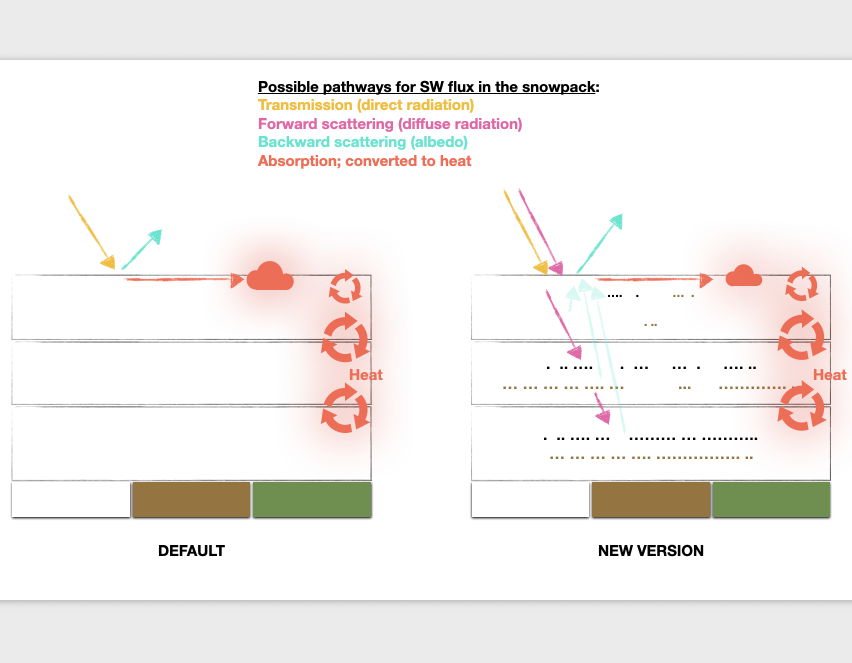- Acronimo
- ICED EARTH
- Area di ricerca
- Earth science
- Tematica specifica di ricerca
- Modelling the impacts of aerosol deposition on snow albedo in global Earth system models
- Regione di interesse
- Arctic (global)
- Sito web progetto
- https://sites.google.com/site/samuelalbani/projects
- PI
- Samuel Albani
- Istituzione PI
- Department of Environmental and Earth Sciences, University of Milano-Bicocca
- Sito web istituzionale
- https://www.unimib.it/samuel-albani
- Altre Istituzioni e soggetti coinvolti
- Scientific collaboration with IGE (Grenoble) and LSCE/IPSL (Gif-sur-Yvette), France
- Consistenza del team ricerca
- PI: Prof. Samuel Albani Postdoc: Dr. Sujith Krishnakumar
- Stato progetto
- Completato
- Il progetto
Could dust contribute to cause the observed abrupt changes in the Arctic? ICED EARTH aims to put the bases to tackle this question through simulations with a global Earth System Model of high complexity (IPSLCM6). Dust-cryosphere processes are only just starting to be fully implemented in global ESMs, often in a fragmented way. In ICED EARTH, deposition of mineral dust and carbonaceous aerosols will be coherently coupled to snow albedo on land. Simulations will be tested against available observations.
- Immagini
-
- Motivazione, importanza della ricerca
Il progetto ha come obiettivo una rappresentazione più realistica delle proprietà ottiche della neve, all’interno di un modello climatico su scala globale. In particolare vogliamo rappresentare l’effetto per così dire “scurente” derivante la deposizione sul manto nevoso di particelle trasportate dal vento, come fuliggine o polveri del deserto.
Localmente, questo può anticipare la stagione di fusione della neve di diverse settimane, mentre su scala regionale o globale potrebbero esserci impatti che aggravano il riscaldamento del pianeta, attraverso quelli che chiamiamo meccanismi di feedback positivo, e anche alterare la circolazione atmosferica.
- Obiettivi della proposta
Alla fine del progetto ci aspettiamo uno strumento per poter effettuare simulazioni più realistiche, attraverso potenti super-computer, per comprendere meglio il ruolo delle polveri depositate sulla neve nell’accelerare o meno i grandi cambiamenti climatici del passato o che potrebbero attenderci nel futuro.
- Attività svolta e risultati raggiunti
Simulating seasonal snow with global general circulation models (GCMs) is challenging. Snow provides fresh water to billions of people and plays an important role in the energy budget of the earth through albedo, which affects not only local but also remote and global climate/hydrological patterns. Therefore, changes in snow amount and length of the season are crucial when investigating climate variability. Only a few GCMs consider Light Absorbing Particles (LAPs) in snow simulations. Existence of LAPs causes a steep decline in the snow albedo over the visible part of solar radiation.
The intention is to lay the foundations for addressing issues of relevance to large spatial spaces (and across different climate conditions) through simulations, by adding the snow darkening effect to a multilayered intermediate complexity scheme within ORCHIDEE, the land surface model embedded in the IPSL Earth System Model. Usually LAPs are deposited on the fresh snow and get buried within.
For this study, a set of tracers were introduced in ORCHIDEE to carry LAP from the top snow layer following atmospheric deposition and move LAPs through the snowpack layers as snow thickens or flushes with meltwater flow. Snow albedo is represented in ORCHIDEE as a function of snow aging through an exponential decay function with dependence on the degree of water saturation and the occurrence of fresh snow deposition. Instead of that, a unique combination of the Warren and Wiscombe snow radiative transfer scheme and Kokhanovsky based single scatter properties of snow crystals are employed along with LAP’s optical properties to calculate the impure snow albedo.
Site level offline ORCHIDEE simulations are performed with corresponding site observed atmospheric forcings and MERRA2 aerosol deposition of dust, black and organic carbon. The incorporation of LAPs and associated processes created realistic variability in the simulation of seasonal snow compared to local observations. Overall, our results show that LAPs play an important role in determining the local snow season length.
- Prodotti
• Krishnakumar S. et al. Manuscript in preparation
• Krishnakumar S. et al. Modeling Physisc-Based Snow Albedo with Light Absorbing Particles: Implications for Snow Simulation in the ORCHIDEE Land Surface Model. 24rd AeroCom / 13th AeroSat workshop, 13–17 October 2025, Institut Pascal, Université Paris-Saclay (France).
• Krishnakumar S., S. Albani, M. Ménégoz, C. Ottlé, Y. Balkanski. Influence of aerosol deposition on snowpack evolution in simulations with the ORCHIDEE land surface model. EGU General Assembly 2024, #EGU24-8749, 14–19 April 2024, Vienna (Austria).
• Krishnakumar S., S. Albani, M. Ménégoz, C. Ottlé, Y. Balkanski. Influence of light absorbing particles on the simulation of snow in ORCHIDEE land surface model. 4th International Conference on Snow Hydrology. 29 Jan-2 Feb 2024 Grenoble (France).
• Krishnakumar S., S. Albani, M. Ménégoz, C. Ottlé, Y. Balkanski. Simulating Snow Changes in the ORCHIDEE Land Surface Model related to Light Absorbing Particles deposition. AGU Fall Meeting 2023, ID# 1260304, San Francisco (USA) 11-15 Dec 2023.
